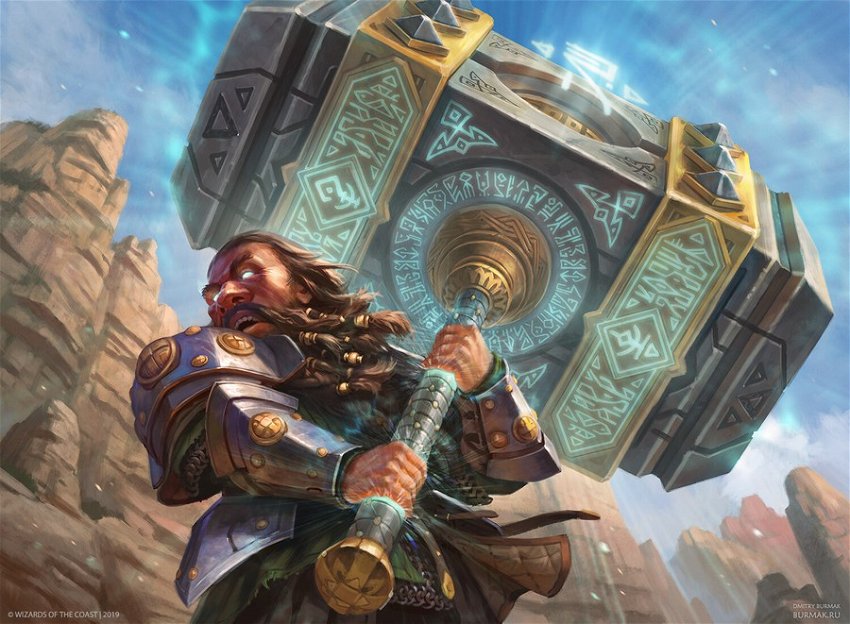Sideboard is arguably one of the most important points in a Magic game, after all, in an official game, 50% to 66.66% of the "Best of Three" is played with the sideboard, so knowing which cards to include and remove in games two and three is pretty crucial in a match. With that in mind, I decided to address this topic for the first time in my articles, making a sideboard guide!
For that, I chose one of the most popular decks in the format. It's relatively new, but since Colossus Hammer was first released, it has captured hearts with its simple yet powerful synergy: Hammer Time!
More precisely, the list that HappySandwich used to take the Top 2 in the 24/10 Modern Challenge.
After several leagues and multiple single matches in Magic Online with the list, I came to share the experience I had with the deck.
Understanding Hammer Time
Hammer Time is a fully combo-centric deck that revolves around synergies between Colossus Hammer and Sigarda's Aid/Puresteel Paladin.
The goal here is to use the aforementioned cards to circumvent the Hammer's self-equipment cost, thus attaching it at a low cost to creatures to deal absurd amounts of damage as soon as possible.
Like Temur Footfalls, it's a deck totally focused on a synergy that, even if it doesn't win the game right away (but here sometimes it does, especially when we attach the hammer to Inkmoth Nexus, which will always threaten lethal damage), will make the advantage remain with you.

Like any combo-centric deck, we need redundancy and consistency in our synergy. For this, in this case we have two super-known and powerful tutors: Urza's Saga which has arrived now, but has already made a big impact on Modern, being useful in several strategies. Here, it's one of the cards we'll use to tutor the Hammer, as well as being a monster in versatility, and also sometimes winning games alone with its construct tokens.
Stoneforge Mystic is a classic Magic card and even without using its traditional swords, it can be useful for our game as another tutor, besides being a body that can hold the Hammer and also be able to play around counterspells.

Unlike what I normally do, here we're going to pay a lot more attention to the sideboard choices on the list, but for that, I need to address a significant point on the maindeck: Thoughtseize and Dark Confidant.
Choosing these cards demonstrates an attempt to bring versatility and resilience from the beginning and, thus, being able to focus the use of the sideboard to protect the combo and deal with more specific strategies, which ends up facilitating the choices and, in the current metagame, I see it as an assertive choice.
The Sideboard

Looking at the side, it becomes even clearer how much the chosen approach was hates against specific strategies in the current metagame, especially when we see cards like Hushbringer, Drannith Magistrate, Void Mirror and Sanctifier en-Vec. It's true that white has several permanents with static abilities that can be punishing to the opponent, and taking advantage of that is quite beneficial.

But some interaction is also needed, and here, white also helps the deck's plan a lot, with Prismatic Ending, Path to Exile and Seal of Cleansing as efficient removals, Nihil Spellbomb as a one-off answer against graveyard strategies that still recurs with Lurrus of the Dream-Den and the latest copy of Thoughtseize for a little more hand disruption.
With this composition, we have a sideboard very focused on what to react and thought to face specific decks, which is a perfect line in a more consolidated Metagame and in an environment where you know what to expect. With that, let's talk about setting up this sideboard against some of the most popular Modern decks today:
vs. Temur Footfalls
IN:

OUT:

As we saw on my article about Temur Footfalls, Cascades don't expect the game to go long, so since even with Thoughtseize we have a lower level of interaction, the approach I think is better is to play "onward" and try to fit our synergy before the opponent fills the board with rhinos.
To slow them down, we have Drannith Magistrate which, in addition to preventing Crashing Footfalls, prevents Brazen Borrower and Bonecrush Giant from leaving the adventure zone.
We also have Void Mirror which blocks both rhinos and Fury cast by evoke. As Void Mirror is a double-edged sword, it is advisable to remove some of our 0 drops, in this case, Mishra's Bauble and Memnite.
In my games I didn't find it necessary, but in case you miss any disruption against the opposing creatures, removing the Dark Confidant to include Path to Exile and Prismatic Ending can help.
vs. Izzet Tempo
IN:

OUT:

It is extremely complex to combo against Izzet Tempo due to its numerous 1 or 2 mana answers, playing too proactively and trying to connect one of the 0 drops with the Hammer in the first turns is very risky. So, here we give up speed to get more consistency.
We look for this with Sanctifier en-Vec, which in addition to messing up Dragon's Rage Channeler and Murktide Regent, has protection from virtually all removals from the opposing deck, so it's a great "Hammer Carrier".
We've also prepared more for the match by increasing our interactions, Prismatic Ending will help stop Ragavan, Nimble Pilferer, the fourth copy of Thoughtseize will give us resilience against sweepers and Path to Exile can save us against Murktide.
vs. Esper Reanimator
IN:

OUT:

Against Reanimator, playing Colossus Hammer as soon as possible is crucial.
Even post-side, the opponent usually doesn't have such a significant number of removals, and the resilience to keep causing pressure with the other pieces in the deck gives us an advantage here.
To stop their combo, we have the Sanctifier en-Vec again, along with Hushbringer, which delays Archon of Cruelty and prevents the effects of Grief and Solitude (in exchange for hindering the ability of our Stoneforge Mystic, so we've reduced their numbers). We've also increased our interaction with Thoughtseize and Path to Exile.
vs. Azorius Control
IN:

OUT:

Here we really don't have much to play with, Thoughtseize and Dark Confidant on maindeck already helps a lot in this type of game, and we can just complement it with a little more interaction with the fourth copy of Seize and with Seal of Cleansing which here can serve as a counterside, removing Chalice of the Void, Stony Silence and other permanents that can hinder us, as well as dealing with Spreading Seas and even in a setting where Shark Typhoon is on the battlefield.
vs. Hammer Time
IN:

OUT:

For the mirror, it's crucial not to take anything out of the combo, this match is a race of who connects the Hammer first. To make sure we go first, our removals can come in handy, not least because, except for Path to Exile, our removals deal with creatures, the Hammer, and Sagarda's Aid.
One card that positively surprised me on mirrors was the Dark Confidant. After his entry, it's much more advantageous to exchange resources with the opponent and overwhelm them with more cards, since it's practically two draws per turn, in addition to having a very low cost and a body that can be useful to carry the Hammer.
Conclusion
This decklist ended up showing us how maindeck choices influences and is influenced by the sideboard, changing both the approach and the choice of what to add or remove on certain match-ups. Defining which proposal you want to play is an important step for a player and/or deckbuilder.
That's all for today
Until next time!















— Comments 0
, Reactions 1
Be the first to comment